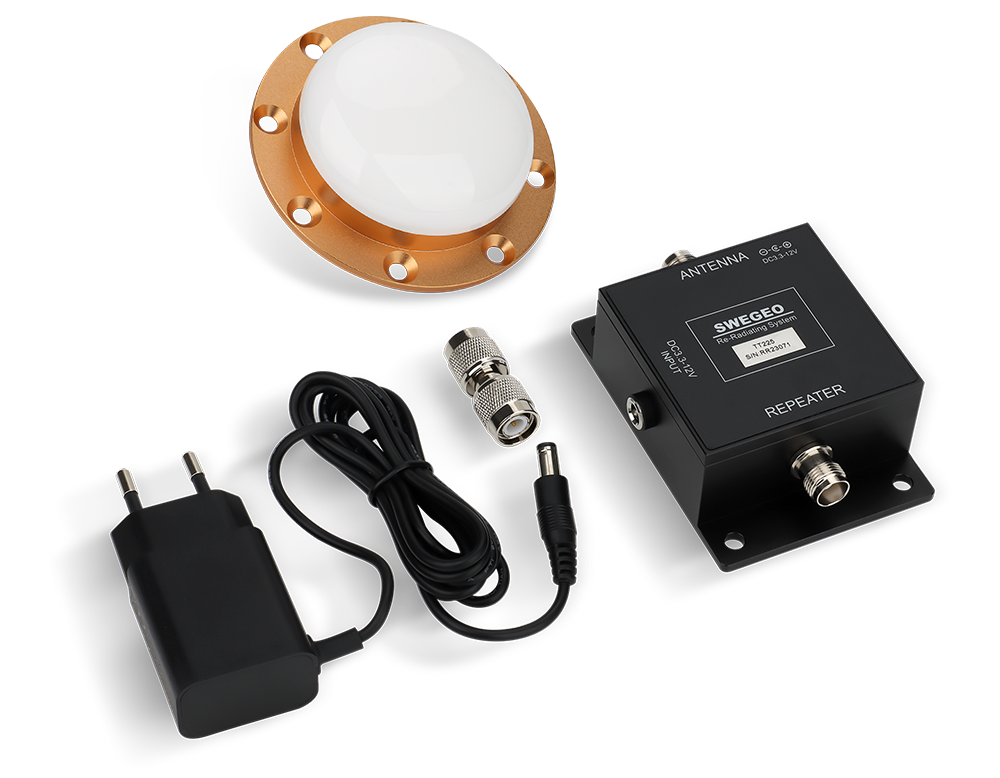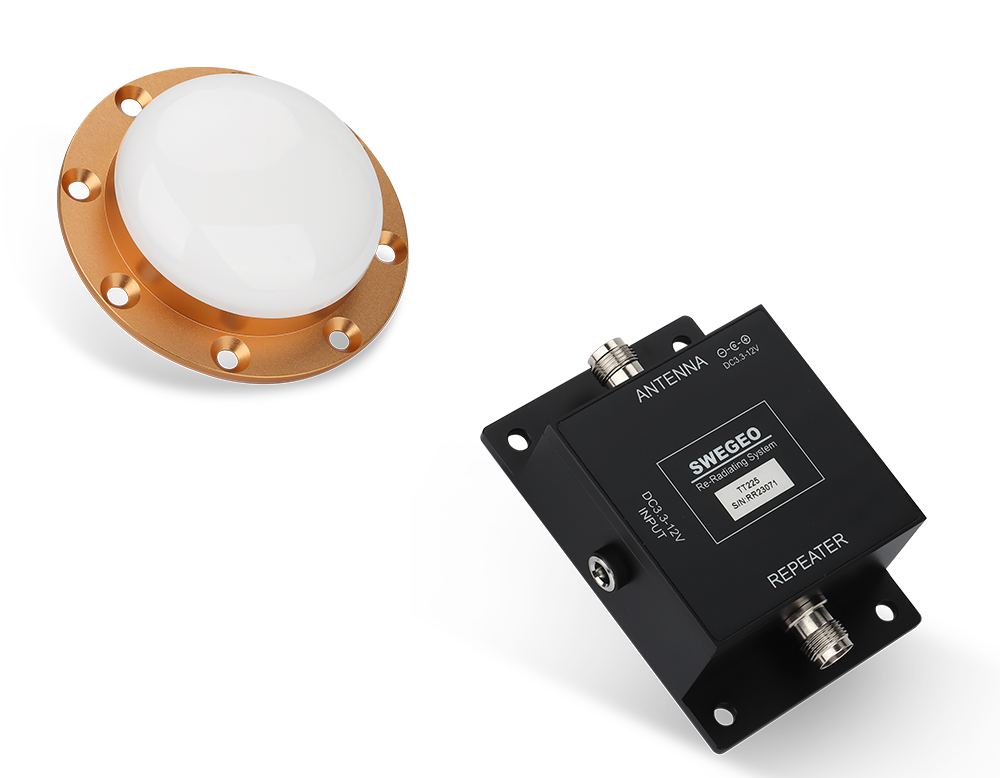

Swegeo TT225
GNSS Repeater
Key Feature
- The TT225 is a compact GNSS signal repeater that integrates a low noise amplifier and filter for high-quality signal processing. It provides DC bias current for external GNSS antennas while simultaneously filtering and amplifying RF signals. The repeater ensures efficient signal relay by forwarding enhanced signals to additional antennas. With its small size, lightweight build, and flat frequency response, the TT225 is perfect for GNSS signal distribution and relay applications.
Integrated Low Noise Amplifier and Filter
Combines amplification and filtering in a single device to ensure high signal quality with minimal noise.
Simultaneous DC Bias Current and RF Signal Processing
Provides DC bias current for external GNSS antenna circuits while also processing RF signals, facilitating efficient and reliable signal handling.
Effective Signal Filtering and Amplification
Filters and amplifies the received GNSS antenna RF signal, enhancing signal strength and clarity before outputting to relay and forwarding antennas.
Compact and Lightweight Design
Features a small, lightweight form factor for easy installation and integration in various setups.
Flat Frequency Response
Maintains consistent performance across the frequency domain, ensuring reliable signal relay without distortion or loss.
Ideal for GNSS Signal Relay
Specifically designed for GNSS signal relay applications, making it well-suited for extending and distributing GNSS signals efficiently.
Indoor GNSS Coverage for Testing & Development:
The TT225 repeater is widely used to bring live GNSS signals inside buildings for test and demonstration purposes. In a GPS device manufacturing plant, for example, engineers set up the TT225 in the warehouse so that handheld GPS units or vehicle trackers can be powered on and get a real satellite fix without leaving the building. This simplifies processes like quality testing or firmware updates—devices think they’re under open sky while actually indoors. The TT225’s integrated low-noise amplifier and filtering ensure that the rebroadcast signals are strong and clean, closely mimicking outdoor conditions. Development teams also use these repeaters in their labs: a drone or robot can be tested for GPS functionality on the bench, or multiple receivers can be compared side by side under identical indoor signal conditions, all thanks to the repeater providing the same satellite feed to the whole room.
Parking Garages and Maintenance Hangars:
Fleet operators and maintenance crews utilize GNSS repeaters like the TT225 to maintain satellite lock on vehicles kept indoors. For instance, in an aircraft hangar, installing a TT225 means a plane’s GPS or an airport vehicle’s GNSS remains operational even inside the hangar, which is crucial for systems that require continuous position (such as an airplane’s navigation aligning or a security vehicle’s tracking device). When the vehicle or aircraft exits the hangar, its GNSS is already active and navigating, eliminating the usual startup delay to reacquire satellites. Similarly, high-end car dealerships or armored vehicle garages might use a repeater so that the vehicles’ navigation and tracking systems remain updated and ready to go at a moment’s notice.
Underground Facilities & Tunnels:
In some cases, TT225 repeaters improve safety and operational continuity by extending GNSS coverage into tunnels or mines. Emergency services may place a repeater at the mouth of a tunnel so that GPS signals propagate a short distance inside, allowing fire trucks or ambulances to retain their GPS position until they are deep in. In mining, a repeater at a mine entrance can help equipment just inside the portal keep time synchronization or receive positioning for as long as possible before switching to inertial navigation. The compact and lightweight design of the TT225 makes it easy to install in such challenging environments, and its flat frequency response means it won’t distort the timing or accuracy of the signals even as it amplifies and relays them.
| Feature | Specification | Feature | Specification |
|---|---|---|---|
| Signal Supported |
GPS: L1/L2/L5 GLONASS: G1/G2/G3 BEIDOU: B1/B2/B3 GALILEO: E1/E5a/E5b/E6 QZSS: L1/L2/L5 IRNSS: L1/L2/L5 SBAS: L1/L2/L5 L-Band |
LNA Gain | 20 ±3.0 dB (Typ. @25°C) |
| Dimensions | 93.5 × 50.0 × 31.8 mm | Connector | TNC-50KY |
| Weight | ≤180 g | Body | Aluminum Alloy 6061-T6 |
| DC Port | DC-022-2.5 (Fitting Φ5.5×2.5 mm) | Attachment | Four screw holes |
| Frequency Range | 1150 ~ 1650 MHz | Operating Voltage | 3.3 ~ 16 V DC |
| Noise Figure | ≤2.0 dB @25°C (Typ.) | VSWR | ≤1.8:1 typ. / 2.0:1 max |
| Operating Current | ≤20 mA | Operating Temperature | -40°C ~ +85°C |
| Storage Temperature | -55°C ~ +85°C | Humidity | 95% Non-condensing |


Swegeo TT225
GNSS Repeater
Key Feature
The TT225 is a compact GNSS signal repeater that integrates a low noise amplifier and filter for high-quality signal processing. It provides DC bias current for external GNSS antennas while simultaneously filtering and amplifying RF signals. The repeater ensures efficient signal relay by forwarding enhanced signals to additional antennas. With its small size, lightweight build, and flat frequency response, the TT225 is perfect for GNSS signal distribution and relay applications.
OVERVIEW
Multi-Constellation GNSS Support
Provides reliable and robust signal reception from GPS, GLONASS, Galileo, and
BeiDou systems, ensuring comprehensive coverage and improved accuracy.
Dual Antenna Configuration
Enhances positioning accuracy and performance, particularly in challenging
environments, by using two antennas to better mitigate signal obstructions and
multipath effects.
USE CASES
Indoor GNSS Coverage for Testing & Development:
The TT225 repeater is widely used to bring live GNSS signals inside buildings for test and demonstration purposes. In a GPS device manufacturing plant, for example, engineers set up the TT225 in the warehouse so that handheld GPS units or vehicle trackers can be powered on and get a real satellite fix without leaving the building. This simplifies processes like quality testing or firmware updates—devices think they’re under open sky while actually indoors. The TT225’s integrated low-noise amplifier and filtering ensure that the rebroadcast signals are strong and clean, closely mimicking outdoor conditions. Development teams also use these repeaters in their labs: a drone or robot can be tested for GPS functionality on the bench, or multiple receivers can be compared side by side under identical indoor signal conditions, all thanks to the repeater providing the same satellite feed to the whole room.
Parking Garages and Maintenance Hangars:
Fleet operators and maintenance crews utilize GNSS repeaters like the TT225 to maintain satellite lock on vehicles kept indoors. For instance, in an aircraft hangar, installing a TT225 means a plane’s GPS or an airport vehicle’s GNSS remains operational even inside the hangar, which is crucial for systems that require continuous position (such as an airplane’s navigation aligning or a security vehicle’s tracking device). When the vehicle or aircraft exits the hangar, its GNSS is already active and navigating, eliminating the usual startup delay to reacquire satellites. Similarly, high-end car dealerships or armored vehicle garages might use a repeater so that the vehicles’ navigation and tracking systems remain updated and ready to go at a moment’s notice.
Underground Facilities & Tunnels:
In some cases, TT225 repeaters improve safety and operational continuity by extending GNSS coverage into tunnels or mines. Emergency services may place a repeater at the mouth of a tunnel so that GPS signals propagate a short distance inside, allowing fire trucks or ambulances to retain their GPS position until they are deep in. In mining, a repeater at a mine entrance can help equipment just inside the portal keep time synchronization or receive positioning for as long as possible before switching to inertial navigation. The compact and lightweight design of the TT225 makes it easy to install in such challenging environments, and its flat frequency response means it won’t distort the timing or accuracy of the signals even as it amplifies and relays them.
APPLICATIONS


TECHNICAL SPECIFICATIONS
| Feature | Specification | Feature | Specification |
|---|---|---|---|
| Signal Supported |
GPS: L1/L2/L5 GLONASS: G1/G2/G3 BEIDOU: B1/B2/B3 GALILEO: E1/E5a/E5b/E6 QZSS: L1/L2/L5 IRNSS: L1/L2/L5 SBAS: L1/L2/L5 L-Band |
LNA Gain | 20 ±3.0 dB (Typ. @25°C) |
| Dimensions | 93.5 × 50.0 × 31.8 mm | Connector | TNC-50KY |
| Weight | ≤180 g | Body | Aluminum Alloy 6061-T6 |
| DC Port | DC-022-2.5 (Fitting Φ5.5×2.5 mm) | Attachment | Four screw holes |
| Frequency Range | 1150 ~ 1650 MHz | Operating Voltage | 3.3 ~ 16 V DC |
| Noise Figure | ≤2.0 dB @25°C (Typ.) | VSWR | ≤1.8:1 typ. / 2.0:1 max |
| Operating Current | ≤20 mA | Operating Temperature | -40°C ~ +85°C |
| Storage Temperature | -55°C ~ +85°C | Humidity | 95% Non-condensing |


